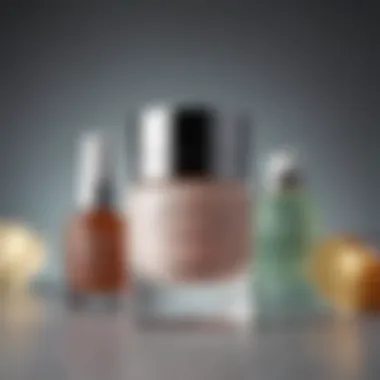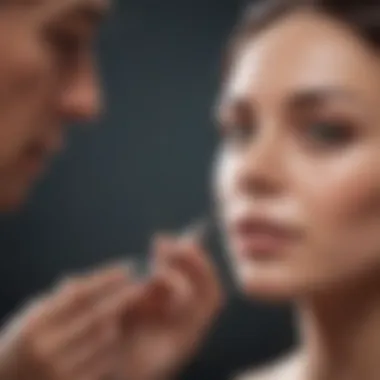A Comprehensive Guide to Repairing Facial Skin


Intro
Skin on our faces faces numerous challenges daily, including environmental factors, aging, and personal habits. Repairing facial skin is a multidimensional endeavor that requires understanding various skin issues and the most effective treatments for them. The quest for healthier skin is universal. From tackling common ailments like acne and sun damage to combating the visible signs of aging, comprehensive skincare is paramount. This guide presents both professional and at-home methods designed to empower individuals to take charge of their skin health.
Effective skin repair is about more than just addressing existing issues. Preventative measures are equally important. This article will provide insights into regimens, products, and lifestyle adjustments that create a robust foundation for lasting skin health.
Fashion Trends
The intersection of skincare and fashion highlights a growing awareness of the importance of maintaining a vibrant complexion. Modern trends embrace holistic approaches to beauty, merging skincare routines with topical treatments that enhance skin texture and appearance.
Skincare and Fashion
Keeping facial skin in optimal condition is a fashion statement in its own right. Here, we explore the trends that influence how individuals approach their skincare routines:
- Runway Highlights: Top designers now emphasize natural beauty, often showcasing models with fresh, dewy skin. This shift has resulted in an emphasis on skincare products that promote skin health.
- Seasonal Must-Haves: With each season, specific skincare products gain popularity. For instance, hydrating serums become essential in winter, while sunscreens dominate summer routines.
- Celebrity-inspired Looks: Many fans of the beauty industry turn to celebrities for inspiration. A clear and radiant complexion is often viewed as a hallmark of beauty, encouraging consumers to invest in effective products.
Beauty Tips and Tricks
The realm of beauty encompasses both straightforward skincare regimens and intricate makeup tutorials. Both require a solid foundation of healthy skin.
Skincare Regimens
Establishing a consistent skincare routine is crucial. Key steps generally include:
- Cleansing - Remove dirt and oil daily.
- Toning - Balance skin pH levels.
- Moisturizing - Keep the skin hydrated and supple.
- Sun Protection - Guard against harmful UV rays.
Makeup Tutorials
Proper makeup application can enhance natural beauty, but individual results are often best achieved with healthy skin underneath. Techniques often highlighted include:
- Choosing non-comedogenic products to avoid clogging pores.
- Blending techniques that enhance one's features while allowing the skin to breathe.
Hair Care Secrets
Healthy hair and skin often go hand in hand. Simple practices can contribute:
- Regular trims to prevent split ends.
- Moisturizing treatments to maintain shine and softness.
"Emphasizing skincare is not just a trend; it reflects a shift in how we perceive beauty itself."
End
Repairing facial skin demands attention from multiple angles—personal care, treatment options, and influenced trends. Understanding these aspects equips anyone with the tools necessary to enjoy healthy and glowing skin.
Understanding Facial Skin
Understanding the structure and characteristics of facial skin is fundamental for anyone looking to improve skin health. Knowledge of how skin functions and what affects it can greatly enhance both repair strategies and prevention methods.
Structure of Facial Skin
Facial skin is complex, comprising multiple layers, each playing specific roles. The epidermis serves as the outer protective layer, providing a barrier against environmental factors. Beneath it lies the dermis, which houses blood vessels, nerves, and connective tissues. Finally, there is the subcutaneous layer, which includes fat and helps anchor the skin to underlying structures. Understanding these layers helps identify how different treatments can penetrate and affect each section.
Common Skin Types
Recognizing your skin type is essential. Each type carries distinctive characteristics that dictate suitable care methods and products.
- Normal: Typically, this skin type has a balanced texture, neither too oily nor too dry. Its key characteristic is a smooth and even appearance. This type often requires minimal care, making it a desirable choice for those seeking simplicity in skincare routines. However, it may still be prone to occasional issues, like minor breakouts.
- Oily: Oily skin produces excess sebum, leading to a greasy appearance. A key characteristic is enlarged pores, which can contribute to acne issues. While this type can offer some protection against aging, it often necessitates rigorous cleansing to avoid clogging pores.
- Dry: Dry skin lacks moisture, presenting a rough texture and potential flakiness. This type often requires moisturizing products to maintain hydration, making it important in discussions about repairing skin. However, overusing heavy creams may lead to clogged pores.
- Combination: Combination skin displays both oily and dry areas, most commonly an oily T-zone and dry cheeks. Its complexity requires tailored treatment methods. Individuals must be cautious when choosing products to not exacerbate either condition.
- Sensitive: Sensitive skin is prone to redness and irritation. This skin type is characterized by reactions to certain products and environmental factors. Due to its delicate nature, it may need gentle and soothing products, which can sometimes limit treatment options for repairs.
Skin Aging Process
The process of skin aging involves changes at both cellular and structural levels. Over time, collagen and elastin production decreases, leading to wrinkles and loss of elasticity. External factors, such as sun damage and pollution, further accelerate this process. Understanding how skin ages helps in creating effective repair strategies. Each individual may experience these effects differently, influenced by genetics, lifestyle, and exposure to harmful elements.
In summary, having a comprehensive understanding of facial skin structure, types, and aging processes lays the groundwork for effective skincare practices. This knowledge provides the basis for subsequent discussions on skin issues and solutions.
Identifying Skin Issues


Identifying skin issues is a crucial aspect of maintaining healthy facial skin. Understanding what specific problems might affect your skin can lead to more effective treatments and preventative measures. Recognizing the issues early allows for timely intervention, which can significantly enhance the overall aesthetic and health of your skin. When you can pinpoint the type of problem you are experiencing, the path towards resolution becomes much clearer. This section will explore the various common skin issues that arise, providing insights into each type and highlighting strategies for addressing them.
Acne and Breakouts
Acne is one of the most prevalent skin concerns. It often manifests as pimples or cysts on the face and can be both distressing and uncomfortable. Several factors contribute to acne, including hormones, diet, and environmental factors. Areas such as the forehead, chin, and cheeks are commonly affected.
Benefits of addressing acne:
- Prevents scarring and long-term skin damage.
- Improves self-esteem and confidence.
- Reduces pain and discomfort associated with inflamed skin.
To combat acne, maintain a consistent skincare routine emphasizing the use of non-comedogenic products. Including cleansers that contain salicylic acid or benzoyl peroxide can also help reduce the severity of outbreaks.
Uneven Skin Tone
Uneven skin tone can result from various factors, including sun exposure, hormonal fluctuations, or genetics. This issue can leave patches of skin looking darker or lighter than the surrounding areas. Common conditions leading to an uneven skin tone include melasma and post-inflammatory hyperpigmentation.
Considerations for improving skin tone:
- Use of brightening agents like Vitamin C or niacinamide.
- Regular exfoliation to promote cell turnover.
Seeking treatments such as chemical peels or laser therapy may also yield positive results by evening out skin tone.
Fine Lines and Wrinkles
Fine lines and wrinkles are a natural part of the aging process. They often start appearing around the eyes and mouth. Sun damage and loss of collagen can accelerate the formation of these signs.
Strategies for managing fine lines:
- Use of hydrating creams rich in hyaluronic acid.
- Incorporating retinoids into your routine can aid in collagen production.
It is important to start addressing these issues early as prevention plays a key role in maintaining youthful skin.
Sun Damage and Hyperpigmentation
Sun exposure can lead to significant damage, including sunburn and the development of hyperpigmentation. Frequent exposure to ultraviolet rays can accelerate the aging process, resulting in dark spots and uneven texture.
Preventative measures include:
- Daily application of a broad-spectrum sunscreen.
- Seeking shade during peak sun hours.
In cases of existing sun damage, products containing ingredients like retinol or prescribed treatments can help fade dark spots over time.
Rosacea and Skin Irritations
Rosacea is a chronic condition characterized by redness and inflammation. It can occur in episodes, often triggered by certain foods or environmental factors. Those with sensitive skin often experience irritation with varying triggers.
Management includes:
- Identifying triggers and adjusting lifestyle accordingly.
- Using gentle, soothing skincare products to minimize flare-ups.
For persistent cases, consulting with a dermatologist can provide access to prescription medications for better control.
Identifying skin issues is the first step towards effective treatment. Understanding your skin's needs is critical for achieving desired results.
Professional Treatments
The pursuit of flawless skin has propelled many individuals to seek out professional treatments. This section examines various interventions available to address specific skin concerns effectively. Professional treatments can yield noticeable results often not achievable through at-home remedies. They are typically administered by trained professionals who understand skin biology and can customize solutions based on individual needs. The advantages of these treatments often include faster results, higher safety standards, and better efficacy.
Chemical Peels
Chemical peels are one of the more popular methods for rejuvenating facial skin. This treatment involves applying a chemical solution to remove the outer layer of skin, allowing for fresh, new skin to emerge. There are different types of chemical peels: superficial, medium, and deep, each varying in strength and purpose. Superficial peels target minor skin issues, while deep peels are more effective for severe imperfections.
Benefits of chemical peels include:
- Improvement in skin texture and tone
- Reduction of fine lines
- Decreased appearance of scars and sun damage


It's crucial to consult with a dermatologist before undergoing this treatment. They can assess skin type and recommend the right peel, ensuring a balance between potential benefits and risks.
Microneedling
Microneedling, also referred to as collagen induction therapy, utilizes fine needles to create micro-injuries in the skin. This process stimulates the body’s natural healing response, promoting collagen and elastin production. The treatment targets issues like fine lines, acne scars, and overall skin texture.
While the results vary from person to person, many observe significant changes after a series of sessions. This method is considered safe, but it’s essential to maintain realistic expectations. Aftercare is vital, as skin will require time to heal.
Laser Therapy
Laser therapy fundamentally alters the way skin issues are addressed. Using targeted light energy, different lasers can treat a variety of skin concerns, including wrinkles, pigmentation, and scarring. Fractional laser treatments are prevalent and can minimize downtime by allowing some areas of skin to heal faster.
Key considerations for laser therapy include:
- Skin type and specific issues
- Potential side effects like redness and swelling
Working with a qualified dermatologist ensures the right type of laser is selected for optimal results.
Dermal Fillers
Dermal fillers have gained traction for their ability to restore volume and smooth wrinkles. They can enhance facial contours, offer lift, and rejuvenate the overall appearance. Common fillers include hyaluronic acid injections, which provide hydration and elasticity.
The benefits of dermal fillers often encompass:
- Immediate results
- Minimal downtime
However, consultation is necessary to understand the types of fillers suitable for individual needs and to discuss any underlying health conditions.
Botulinum Toxin Injections
Botulinum toxin, commonly known as Botox, has made its mark in cosmetic procedures aimed at reducing dynamic wrinkles. It works by blocking nerve signals in the muscles, thereby softening the appearance of lines, particularly around the forehead and eyes.
Patients appreciate the quick sessions, typically lasting only a few minutes, with results visible within days. Important aspects to consider before treatment:
- Understanding the effects and longevity of the results
- Finding a certified and experienced provider
Each professional treatment offers unique benefits tailored to address specific skin concerns. Consultation with experts can aid in determining the most suitable methods for individual skin types and issues, leading to healthier, more radiant skin.
At-Home Remedies
At-home remedies play a significant role in maintaining and repairing facial skin. They offer accessible options for individuals seeking healthier skin without the need for expensive treatments. Many people prefer these methods because they can be easily incorporated into daily life, providing a sense of control over one’s skincare routine. Furthermore, using at-home remedies allows for experimentation with natural ingredients, which can be more gentle and less likely to irritate the skin compared to some commercial products. However, it is essential to consider individual skin types and conditions when choosing any remedy, as different approaches may not work for everyone.
Daily Skincare Routine
Cleanser
A good cleanser is crucial for healthy skin. It removes dirt, excess oil, and impurities. Cleansers can be formulated for different skin types, such as foaming cleansers for oily skin or cream cleansers for dry skin. A well-chosen cleanser contributes to maintaining a balanced skin environment, preventing breakouts, and keeping the skin clear. However, some cleansers can be too harsh, stripping natural oils and leading to dryness. Therefore, individuals should look for products that suit their skin type.
Toner
Toners serve to restore the skin’s pH balance after cleansing. They can also remove any residual impurities left behind. Alcohol-free toners are often popular choices because they are less likely to cause irritation. Using a toner can enhance skin texture and prepare it for subsequent skincare products. However, it is essential to choose a formulation that suits one’s needs; some toners may claim to have too many active ingredients and cause sensitization.
Moisturizer
Moisturizers are vital in preventing water loss and keeping the skin hydrated. They can come in various forms, such as lotions or creams, and should be selected based on skin type. For example, heavier creams are often beneficial for dry skin, while lighter gels can work better for oily skin. A good moisturizer keeps the skin plump and can help minimize the appearance of fine lines. However, one should be cautious with overly occlusive products that could lead to clogged pores, particularly in those prone to acne.
Exfoliation
Exfoliation helps remove dead skin cells, promoting cell turnover and revealing fresh skin underneath. It can be done using physical exfoliants, like scrubs, or chemical exfoliants, which include alpha-hydroxy acids or beta-hydroxy acids. Regular exfoliation can improve the overall texture and appearance of the skin. Nonetheless, over-exfoliating can lead to irritation and damage the skin’s barrier, making it vital to strike a balance in frequency and method used.
Natural Treatments
Aloe Vera
Aloe Vera is well-regarded for its soothing and moisturizing properties. It can help to calm irritated skin and reduce redness. Its key characteristic is the abundance of vitamins and antioxidants, making it a beneficial choice for various skin types. Aloe Vera is particularly known for its healing effects on sunburned skin. However, some individuals may be sensitive to it, so patch testing is recommended.


Tea Tree Oil
Tea Tree Oil is celebrated for its antibacterial and anti-inflammatory properties. It aids in treating acne by keeping bacteria at bay and reducing inflammation. As a popular natural remedy, it can be effective when diluted and applied to affected areas. Nonetheless, it is potent, and using it undiluted may cause skin irritation. Careful application and dosage are important in achieving desired effects without side effects.
Vitamin E
Vitamin E is an excellent antioxidant known for its protective benefits and promoting skin healing. Many skincare products incorporate this ingredient due to its moisturizing properties as well. It plays a role in improving skin texture and luminosity. However, individuals with oily skin should be cautious, as pure Vitamin E oil might feel heavy and could lead to breakouts.
Green Tea Extract
Green Tea Extract is packed with antioxidants that protect the skin from environmental stressors. It helps in reducing inflammation and can prevent signs of aging. Its unique feature lies in its ability to offer both topical and internal benefits. While it is generally well-tolerated, some might experience reactions to topical applications, so it is important to test it first.
Hydration Techniques
Water Intake
Proper water intake is fundamental for skin health. Staying hydrated helps maintain the skin’s moisture balance and can influence its overall appearance. Adequate hydration can prevent dryness and flakiness. However, relying solely on water may not suffice for those with specific skin conditions. Other factors, like nutrition and skincare products, play vital roles in achieving optimal skin hydration.
Humidifiers
Using humidifiers can help combat dry skin, especially in arid environments. They add moisture to the air, benefiting those who struggle with dryness at home. Humidifiers can soften the skin, making it feel more comfortable. Despite these benefits, proper maintenance of the devices is crucial to avoid issues such as mold and bacteria buildup, which can adversely affect skin health.
Overall, at-home remedies are an accessible approach to skincare. However, it is vital to tailor options to individual needs for the best results.
Preventative Measures
Preventative measures play a crucial role in maintaining the health and appearance of facial skin. Understanding these strategies can help individuals minimize damage and prolong the skin's youthful qualities. Proper skincare, alongside lifestyle alterations, can create a foundation for resilience against various skin concerns. This section will explore key elements, including the application of sunscreen, healthy lifestyle choices, and the importance of avoiding skin irritants.
Sunscreen Application
Sunscreen is a vital aspect of skincare that often goes overlooked. Regular application can safeguard the skin from harmful UV rays. These rays contribute to long-term damage, including premature aging, sunspots, and even skin cancer. Using a broad-spectrum sunscreen with an SPF of at least 30 is recommended for daily use. The benefits include protecting against both UVA and UVB rays, reducing the risk of skin conditions, and maintaining an even skin tone. Remember to reapply every two hours, especially during outdoor activities. This simple step can have profound effects on overall skin health.
Healthy Lifestyle Choices
Balanced Diet
A balanced diet is essential for skin health. It involves consuming a mix of nutrients, vitamins, and minerals that cater to the skin's needs. Foods rich in antioxidants, such as berries and leafy greens, support skin repair and protect against oxidative stress. Including healthy fats from sources like avocados and nuts helps in maintaining skin hydration. The key characteristic of a balanced diet is its diversity, offering a range of nutrients that promote overall wellness. This multifaceted approach can boost the skin's appearance while providing energy and health benefits.
Regular Exercise
Engaging in regular exercise contributes significantly to skin clarity and vitality. Physical activity enhances blood circulation, which in turn promotes the supply of oxygen and nutrients to the skin. This process supports the turnover of skin cells, helping to remove toxins. A unique feature of regular exercise is its ability to reduce stress levels, which is beneficial since stress can lead to skin issues like acne or eczema. By integrating exercise into daily life, individuals can experience both physical and aesthetic rewards that reflect in their complexion.
Proper Sleep
Proper sleep is often underappreciated in skin care discussions. During sleep, the body engages in repair processes, including skin regeneration. A consistent sleep schedule allows for the release of growth hormones and minimizes stress hormones that can adversely affect skin health. The key trait of proper sleep lies in its restorative properties; it enhances the skin’s natural glow and texture. Lack of sleep can lead to dark circles and dullness, indicating the importance of prioritizing this aspect. Establishing a calming bedtime routine may enhance sleep quality, resulting in visible gains in skin health.
Avoiding Skin Irritants
Avoiding skin irritants is fundamental in preventing skin issues. Common irritants include certain skincare products, harsh cleansers, and environmental factors. It is important to identify and minimize exposure to these irritants. Choosing products with minimal and non-comedogenic ingredients can be beneficial. Additionally, individuals should stay mindful of their environment. Pollution and allergens can also contribute to skin damage. By carefully selecting products and being aware of external influences, one can better protect their facial skin from unnecessary harm.
"Preventative care is far more effective than reactive measures. Taking control of your skincare today will pay off in the long run."
Embrace these preventative measures to ensure that the facial skin remains healthy, youthful, and vibrant. Implementing these strategies allows individuals to gain a sense of control over their skin health journey.
The End
Understanding facial skin repair is vital for anyone seeking to maintain their skin’s health and appearance. This article has explored various aspects of skin health, touching upon issues like aging, acne, and sun damage. Each section provided insights into both professional treatments and at-home remedies that can significantly improve skin quality.
Key Points
- Holistic Approach: It is essential to view skin care as a combination of preventive measures, treatments, and lifestyle choices. By integrating protective and reparative practices, individuals can achieve a steadier course toward healthier skin.
- Awareness of Skin Conditions: Recognizing specific skin issues allows individuals to choose the most appropriate methods for treatment. By understanding the main issues, such as rosacea or hyperpigmentation, one can select remedies with higher efficacy.
- Diverse Treatment Options: The range of available treatments—ranging from chemical peels to natural ingredients like aloe vera—provides flexibility. This ensures that everyone can find a tailored approach that fits their unique needs and preferences.
"Skin is the body’s largest organ, and caring for it is paramount for overall well-being."
Benefits of a Repair Strategy
- Improved Confidence: Healthy skin enhances appearance and can significantly boost self-esteem.
- Long-Term Health: Preventative care not only addresses current problems but also helps in combating future skin issues.
- Customization: With both professional and home-based strategies, individuals can adapt their skin care routine to fit their lifestyle and skin type.
Considerations
- Consistency is Key: Regular adherence to skincare regimens improves the chance of successful outcomes. Skipping treatment or neglecting preventive measures can lead to unwanted complications.
- Realistic Expectations: While many products and treatments can enhance appearance, results take time. Patience and perseverance are essential for effective skin repair.
In summary, this guide not only emphasizes the need for understanding skin better but also empowers individuals to take action towards achieving healthier skin. By applying the knowledge from this article, readers are equipped to confront their skin issues with confidence. Dark spots, wrinkles, and other imperfections can significantly be addressed by committing to a thoughtful skin care journey.















